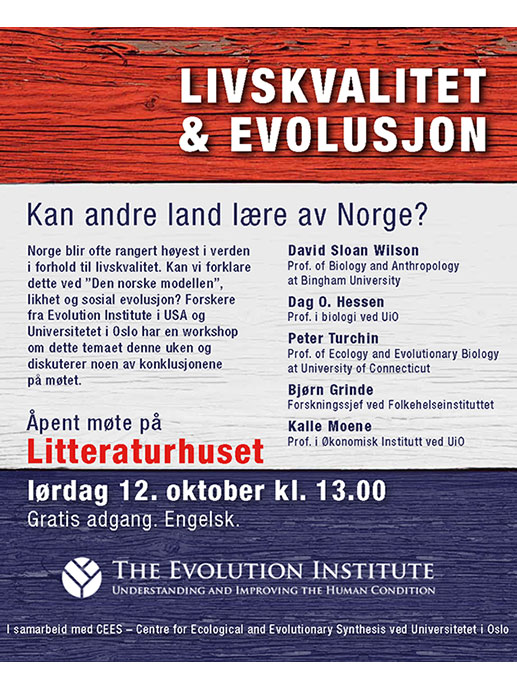Others - Page 19
This Friday we will discuss a recent paper on human evolution by Helen Kurki: 'Bony Pelvic Canal Size and Shape in Relation to Body Proportionality in Humans'.
This week we will read a paper entitled "Genetic incompatibilities are widespread within species" by Corbet-Detig et al. (Nature 2013). The authors have used Drosophila melanogaster lines to detect the genomic footprints of epistasis.
We will discuss sequencing technologies for transcriptome dat. We will focus on the downstream analyses and use the Pacbio human transcriptome paper as a starting point for our meeting (Sharon et al. 2013 A single-molecule long-read survey of the human transcriptome. Nature Biotechnology 31: 1009-1014).
In the Macroevolution and Red Queen Journal Club on Friday 15th we will discuss Hiroshi C. Ito et al. 2009 paper on food-web development, 'Coevolutionary dynamics of adaptive radiation for food-web development'.
This week we will meet and discuss a paper on convergent macroevolutionary landscapes and Anolis radiations by Mahler et al. published in Science earlier this year.
This Friday we will discuss Carl Simpson's 2013 paper on species selection and macroevolutionary change, "SPECIES SELECTION AND THE MACROEVOLUTION OF CORAL COLONIALITY AND PHOTOSYMBIOSIS".
This Thursday we will meet and discuss genome-wide patterns of introgression and how divergence evolves during the speciation process. The paper of the week is entitled "Hybridization Reveals the Evolving Genomic Architecture of Speciation" (Kronforst et al. 2013, Cell Reports). The authors have compared full genome sequences of five species of hybridizing Heliconius butterflies to gain insight into how the genome diverges during speciation.
Lex Nederbragt will present visualisations in the demonstrate the IGV Genome Browser from the Broad Institute, using two validated assemblies.
In the Macroevolution and Red Queen Journal Club on Friday we will read the Lang et al 2013 paper on experimental macroevolution, 'Pervasive genetic hitchhiking and clonal interference in forty evolving yeast populations'
This week we will discuss a recent paper by Gagnaire et al. entitled The genetic architecture of reproductive isolation during speciation-with-gene-flow in lake Whitefish species pairs assessed by RAD sequencing (Evolution, 2013) in the Speciation Journal Club.
A collection of recent CEES publications
Mikael Fortelius is visiting this week, so we will discuss a ruminant paper by Heywood (Bio. J Linn. Soc. 99:657-672)
This week we will read about variation in human skull fossils and its connection with species diversity in early Homos (A Complete Skull from Dmanisi, Georgia, and the Evolutionary Biology of Early Homo - Science 2013), and to add to that, another small perspective paper on hybridization in archaic humans (Did the Denisovans Cross Wallace's Line? - Science 2013), which will surely provide plenty of material for a very interesting discussion. All from the latest issue of Science.
Late lunch talk by Silva Uusi-Heikkilä
We will discuss quality control! The following paper will be a starting point for our discussion: Guo et al. 2013 Three stage quality control strategies for DNA resequencing data (Briefings in Bioinformatics 2013: online early)
In the Macroevolution and Red Queen Journal Club we will stick with the topic of punctuated equilibrium for one more week and we will read Pennell et al.'s recent paper 'Is there room for punctuated equilibrium in macroevolution'?
With among others David Sloan Wilson and Dag O. Hessen
This week we will meet and discuss two papers: one by The Heliconius Genome Consortium entitled: "Butterfly genome reveals promiscuous exchange of mimicry adaptations among species" and another by Durand et al. entitled "Testing for Ancient Admixture between Closely Related Populations".
This Friday we will discuss a new review paper by Vermeij on his "Escalation" theory, which he sees as the viable alternative to the Red Queen hypothesis. The paper is a long verbal argument, but gives some context to the points made about the Red Queen in the recent paper by Vermeij & Roopnarine in Paleobiology.
This week we discuss a paper by Berenos, Schmid-Hempel and Wegner entitled "Antagonistic Coevolution Accelerates the Evolution of Reproductive Isolation in Tribolium castaneum".
A collection of recent CEES publications
We'll have a brainstorm on SNP calling from whole genome sequencing data. I'll briefly describe the pipeline I've run up to now, which is mostly preceding actual SNP calling, and then want to focus the discussion on how to get a high quality SNP dataset from low coverage resequencing - i.e. how to call SNPs, what filtering criteria to use to distinguish high from low quality SNPs, and how this may vary depending on the subsequent analyses we want to do with our SNP data. This will really be a brainstorm, an open discussion, all ideas welcome. If you would like to read up a bit beforehand, I can recommend the guide form the Broad Institute which has been one of my guidelines along the way (http://www.broadinstitute.org/gatk/guide/best-practices).
This Friday we read Jablonski's new paper in PNAS on an old topic: "out of the tropics".
This Thursday we will meet and discuss Christopher H. Martin and Peter C. Wainwright's paper "Multiple Fitness Peaks on the Adaptive Landscape Drive Adaptive Radiation in the Wild" published in Science earlier this year.
